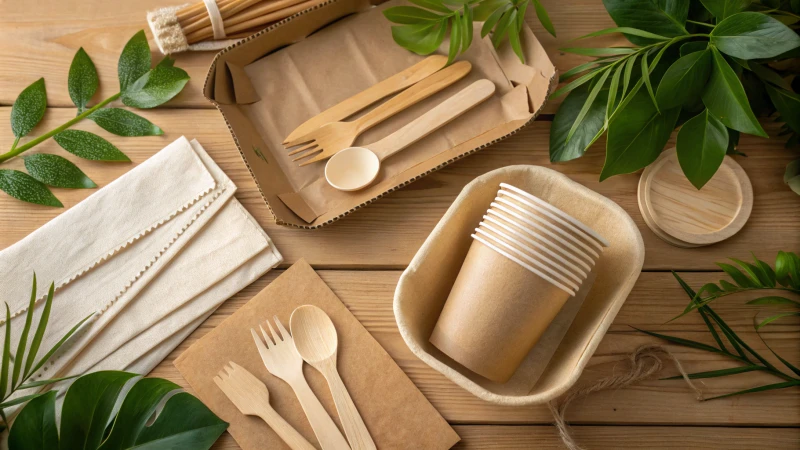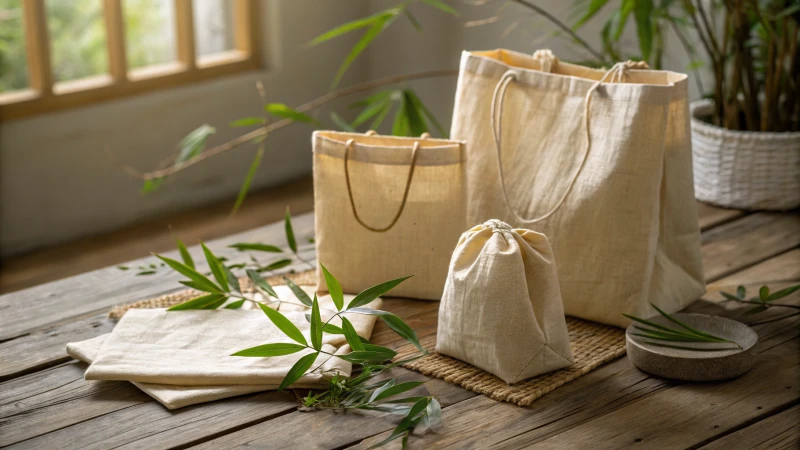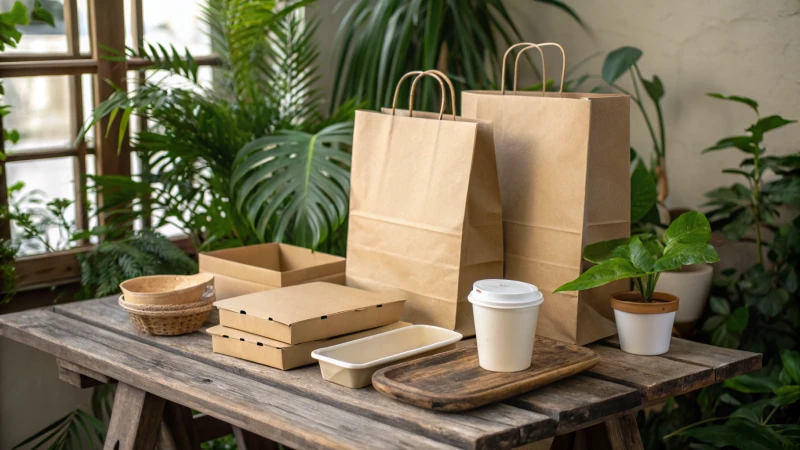
Imagine standing in a bustling kitchen, weighing the impact of every choice you make—sustainability isn’t just an option; it’s a responsibility.
Biodegradable plastics, bamboo fiber paper, and recyclable materials top the list of eco-friendly packaging solutions for disposable wooden cutlery. These options not only protect your cutlery but also resonate with eco-conscious customers, aligning with sustainability standards and enhancing your brand's green image.
I remember the first time I had to decide on packaging for my wooden cutlery line. It felt like choosing a reflection of my values. I quickly learned that while it's easy to identify materials like biodegradable plastics or bamboo fiber paper, understanding their true impact on both the environment and consumer perception required deeper insight. This journey was about more than just protecting my products; it was about making a statement and connecting with customers who care about our planet.
In exploring these options, I found that certifications played a crucial role in validating my choices. They offered reassurance to my buyers, proving that my products met stringent environmental standards. And then there were the stories of other businesses that had successfully transitioned to sustainable packaging, which inspired me to persevere.
Ultimately, the decision wasn't just about the materials themselves but how they aligned with my brand's story—a story of commitment to a greener future and a genuine connection with consumers who share that vision.
Biodegradable plastics are eco-friendly for cutlery packaging.True
Biodegradable plastics decompose naturally, reducing environmental impact.
Recyclable materials harm the environment more than non-recyclables.False
Recyclable materials reduce waste and conserve resources, aiding sustainability.
Why Choose Biodegradable Packaging for Wooden Cutlery?
Have you ever wondered why opting for biodegradable packaging with wooden cutlery matters so much?
Choosing biodegradable packaging for wooden cutlery significantly reduces plastic waste, aligns with sustainable practices, and enhances the natural charm of wooden utensils. This eco-friendly decision not only supports environmental responsibility but also meets the rising consumer demand for sustainable products.

The Environmental Impact of Biodegradable Packaging
Imagine this: a picnic at my favorite park, surrounded by lush greenery, and knowing that the packaging from my lunch won’t linger longer than the memory itself. Biodegradable packaging breaks down quickly, unlike traditional plastics that stick around for centuries. This means less landfill waste and a smaller ecological footprint for the products we love.
Biodegradable packaging significantly reduces environmental waste. Traditional plastic packaging materials1 can take hundreds of years to decompose, whereas biodegradable options break down more quickly, reducing landfill contributions. This process lessens the ecological footprint of products and enhances their appeal to eco-conscious consumers.
Consumer Demand for Eco-Friendly Products
I remember chatting with a friend who works in retail, and she mentioned how customers are more conscious than ever about their purchases. A staggering 70% of them actively seek out products with sustainable packaging. It's not just about being trendy—it's about leaving a lighter mark on our planet, a sentiment shared by many as climate change becomes a pressing issue.
Consumers are increasingly opting for eco-friendly products. A study found that over 70% of consumers prefer products with sustainable packaging. This shift is driven by growing awareness of climate change and the desire to minimize personal impact on the environment. Brands adopting biodegradable solutions are more likely to attract these discerning buyers.
| Consumer Preference | Percentage |
|---|---|
| Eco-Friendly Packaging | 70% |
| Traditional Packaging | 30% |
Practical Benefits of Biodegradable Options
From cornstarch to sugarcane, biodegradable packaging materials are often derived from renewable sources, supporting sustainable agriculture. When I first learned about this, it was like a lightbulb moment—realizing that these options don't just benefit the earth but also comply with regulations on waste reduction. For businesses, this is a win-win.
Besides environmental advantages, biodegradable packaging is often made from renewable resources like cornstarch or sugarcane. This not only supports sustainable agricultural practices but also ensures the material's2 availability. For businesses, switching to biodegradable packaging can mean complying with regulations on waste reduction and sustainability.
Industry Case Studies
Some companies have already made the switch and are reaping the rewards. Take a major fast-food chain; they saw a 20% bump in customer satisfaction after going eco-friendly with their packaging. It's clear: when you choose biodegradable packaging for your wooden cutlery, you’re not just making an environmental statement but also boosting your brand’s appeal.
Several companies have successfully transitioned to biodegradable packaging, witnessing increased consumer engagement and brand loyalty. For instance, a leading fast-food chain saw a 20% increase in customer satisfaction after implementing eco-friendly packaging solutions.
If you're considering this step for your wooden cutlery, these examples show how practical and marketing benefits come hand in hand when you make this conscious choice.
Biodegradable packaging reduces landfill waste.True
Biodegradable packaging decomposes faster, minimizing landfill contributions.
70% of consumers prefer traditional packaging.False
Over 70% of consumers prefer eco-friendly, sustainable packaging.
How Do Bamboo Fiber Paper Bags Enhance Sustainability?
Ever thought about how something as simple as a paper bag can impact our planet? Bamboo fiber paper bags might be the answer.
Bamboo fiber paper bags enhance sustainability by offering a biodegradable, renewable, and eco-friendly alternative to plastic and traditional paper bags. They reduce environmental impact by promoting sustainable consumption.

The Rise of Bamboo as a Sustainable Resource
When I first heard about bamboo growing over a yard in a single day, I couldn't believe it! This rapid growth means bamboo can keep up with demand without depleting resources. Unlike trees that can take decades to mature, bamboo bounces back quickly after harvesting, which doesn't kill the plant. This makes bamboo an incredibly renewable resource3—one that's as resilient as it is versatile.
Biodegradability of Bamboo Fiber Bags
I remember when my friend switched to using bamboo fiber bags for her business. She was amazed at how fast they decomposed compared to the stubborn plastic bags that can stick around for centuries. Bamboo fiber bags break down naturally in just a few months, slashing landfill waste and keeping oceans clear of plastic. Just imagine the lifecycle of a bamboo bag:
| Stage | Duration |
|---|---|
| Usage | Weeks/months |
| Decomposition | 3-6 months |
Environmental Impact Reduction
I always felt a pang of guilt whenever I thought about how many trees were cut down for paper bags. But bamboo changes the game. Its quick regrowth helps reduce deforestation, providing a sustainable option that also absorbs carbon dioxide and releases oxygen. That's like giving our ecosystem a big breath of fresh air! This contributes to a healthier ecosystem4.
Promoting Sustainable Consumer Habits
Switching to bamboo fiber bags isn't just about personal choice—it's a ripple effect. When I started using them, I noticed more friends doing the same. It turns out, retailers offering bamboo bags are making bold statements about their commitment to sustainability, which attracts eco-conscious customers5 who care about the planet.
Comparison with Traditional Materials
Here's how bamboo stacks up against other materials:
| Material | Renewability | Biodegradability | Environmental Impact |
|---|---|---|---|
| Bamboo Fiber | High | High | Low |
| Plastic | None | None | High |
| Traditional Paper | Moderate | Moderate | Moderate |
By considering these factors, both businesses and consumers can make smart decisions that push us all closer to a sustainable future. After all, every small step counts towards preserving our beautiful planet for generations to come.
Bamboo grows up to 35 inches per day.True
Bamboo is a fast-growing plant, capable of growing 35 inches daily.
Plastic bags decompose faster than bamboo bags.False
Plastic bags take centuries to decompose, unlike bamboo bags which take months.
What Certifications Should You Look for in Eco-Friendly Packaging?
Remember the last time you picked up a product and felt good about your choice because it was eco-friendly? That satisfaction often comes down to the certifications behind the packaging.
When choosing eco-friendly packaging, look for certifications like FSC, BPI, and Cradle to Cradle. These ensure the packaging is sustainably sourced, biodegradable, or recyclable, meeting environmental standards and boosting your brand's green credentials.

Understanding Eco-Friendly Packaging Certifications
I remember standing in the aisle of my local store, overwhelmed by choices. I wanted to make a decision that was not just good for my family but also for the planet. That's when I realized how important it is to understand what those little symbols on the packaging mean—those certifications can be our guide!
Selecting eco-friendly packaging requires understanding the certifications that validate sustainability claims. These certifications ensure that products meet rigorous environmental standards, offering assurance to both businesses and consumers.
| Certification | Description |
|---|---|
| FSC (Forest Stewardship Council) | Guarantees that the wood used in packaging is sourced from responsibly managed forests. |
| BPI (Biodegradable Products Institute) | Verifies that packaging is compostable and biodegradable under specific conditions. |
| Cradle to Cradle | Assesses products for safety to humans and the environment, and design for future life cycles. |
The Role of FSC Certification
Once, while I was working with a company dedicated to sustainability, I learned about the FSC certification6. It’s like a badge of honor for businesses committed to responsible forest management. Knowing that a product meets FSC standards gives me peace of mind, whether I’m buying school supplies for my kids or selecting packaging for our company’s products.
For instance, companies using FSC-certified packaging can confidently market their products as environmentally friendly, appealing to eco-conscious consumers while adhering to legal requirements.
Exploring BPI Certification
Have you ever wondered what happens to your waste after it leaves your home? BPI certification can provide some answers. When our local café switched to BPI-certified cups and containers, I felt proud knowing that my coffee habit wasn't adding to landfill woes. BPI ensures these materials break down in compost facilities, turning yesterday’s trash into tomorrow’s soil.
By choosing BPI-certified products, companies like restaurants and cafes can significantly reduce landfill waste while promoting sustainable practices.
The Cradle to Cradle Approach
Thinking about the future often makes me reflect on what kind of world we’re leaving behind. That's why Cradle to Cradle certification resonates with me. It's a comprehensive approach, assessing everything from material health to renewable energy use. It challenges companies to think long-term, designing products that are safe and sustainable through their entire lifecycle.
Brands adopting Cradle to Cradle certified packaging not only support sustainability but also enhance their corporate social responsibility credentials.
Additional Certifications to Consider
There are other certifications that can guide our eco-friendly choices:
- ISO 14001: Focuses on effective environmental management systems.
- Green Seal: Offers certification for products meeting high environmental standards.
By understanding these certifications and their implications, businesses can make informed decisions that align with sustainable practices and consumer demands for eco-friendly solutions. Choosing certified packaging not only protects our planet but also elevates brand reputation in an increasingly eco-conscious marketplace.
FSC certification ensures sustainable wood sourcing.True
FSC guarantees wood is from responsibly managed forests.
BPI certification applies to all types of packaging materials.False
BPI is specific to compostable and biodegradable packaging.
How Does Eco-Friendly Packaging Boost Brand Perception?
Ever wondered how something as simple as a switch to eco-friendly packaging could transform your brand's image? Let’s unpack the magic behind it.
Eco-friendly packaging boosts brand perception by aligning with consumer values, showing dedication to sustainability, and standing out in competitive markets. This approach not only attracts eco-conscious customers but also builds loyalty and trust.

Consumer Alignment and Brand Values
I remember when I first saw a major brand switch to eco-friendly packaging. It was like seeing a glimpse of the future—a world where my purchases didn’t come with a side of guilt. This shift not only made me feel good about my choices but also forged a deeper connection with the brand. Brands adopting eco-friendly packaging are essentially saying, "Hey, we care about the same things you do!" This resonance can lead to a loyal customer base that feels emotionally invested.
Competitive Differentiation
In today’s crowded market, standing out is everything. I often find myself choosing products not just for their function but for what they represent. When I see a product wrapped in sustainable materials like bamboo or biodegradable plastics, it tells me this brand is forward-thinking and cares about the planet's future as much as I do.
| Material Type | Eco-Friendly Attributes |
|---|---|
| Bamboo Fiber Paper Bags | Biodegradable, renewable resource |
| Biodegradable Plastics | Reduced environmental impact, decomposes naturally |
This kind of differentiation isn’t just good for business—it’s essential for connecting with customers who want to make a difference with their purchases.
Building Trust and Loyalty
Trust is the bedrock of any great relationship. I’ve found that brands using eco-friendly packaging earn my trust by being transparent about their sustainable practices7. Certifications like FSC or Cradle to Cradle are more than just stamps—they’re assurances that I’m supporting genuine efforts to protect our planet. This transparency is key in building long-term loyalty.
Impact on Brand Image
Choosing eco-friendly packaging can transform a brand's image, painting it as responsible and compassionate. With growing awareness of environmental issues, customers like me are increasingly supportive of brands that actively work to minimize their ecological impact. This positive perception can translate into customer advocacy and improved brand reputation8.
By weaving these elements into their strategies, brands can significantly enhance how they're perceived, forging deeper connections without overpromising on outcomes.
Eco-friendly packaging builds consumer trust.True
Eco-friendly packaging signals transparency and commitment, fostering trust.
Using bamboo in packaging is not eco-friendly.False
Bamboo is biodegradable and renewable, making it eco-friendly.
Conclusion
Explore eco-friendly packaging solutions for disposable wooden cutlery, including biodegradable plastics and bamboo fiber paper, which enhance sustainability and align with consumer demand for environmentally responsible products.
-
Understand how traditional plastics affect ecosystems and why biodegradable alternatives are beneficial. ↩
-
Explore how renewable resources contribute to sustainability and why they're preferred in modern packaging solutions. ↩
-
Explore how bamboo's rapid growth makes it a more sustainable alternative to traditional wood sources. ↩
-
Discover the environmental benefits of growing bamboo, including carbon sequestration and habitat preservation. ↩
-
Understand the impact of eco-conscious consumer behavior on market trends and product offerings. ↩
-
Learn how FSC certification ensures responsibly sourced materials, supporting forest conservation and sustainability. ↩
-
Learn about sustainable packaging practices that build consumer trust and support brand transparency. ↩
-
Understand how eco-friendly packaging can enhance a brand's reputation and lead to increased customer advocacy. ↩

